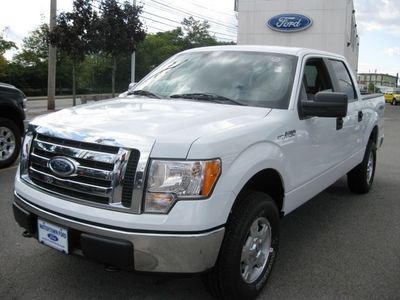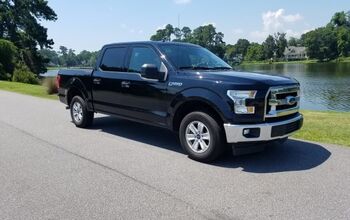Review: 2010 Ford F-150 XLT SuperCab 2WD
If “the truth will set you free,” as both the Good Book and the founder of this website maintain, then I should probably take this opportunity to come clean: When it comes to trucks, I’m seriously prejudiced in favor of substance over style – which means that most modern trucks are, for my tastes, too light on the former and too heavy on the latter.
For this reason, I purposefully chose to review the two-wheel-drive, XLT SuperCab version of the 2010 Ford F-150. It sits third-from-the-bottom in Ford’s nine-step F-150 model line and seems to represent a greater value than its more up-market siblings. Mainly, though, I was attracted to the fact that it wasn’t drenched in gratuitous glitz like some other prominent members of the F-150 family (I’m stink-eyeing you, Platinum Edition).
That’s not to say the XLT is a shrinking violet, as illustrated by the hardest working grille in show(-off) business (“Say it loud…I’m bright and proud!”). Overall, though, the current F-150 seems a little less coherent in design than F-Series past. Chalk some of this up to the chunky proportions created by higher bed rails, a larger extended cab area, and a shorter rear overhang, all hallmarks of modern pickup design. There are sound engineering reasons for these elements, though, and I can live with the frump of functionality. But other aesthetic anomalies escape explanation: for some reason, the three horizontal creases running the width of the tailgate (terminating into the taillight lenses) appear only at the rear and aren’t continued down the sides of the truck (a la the Ford Flex). Also, the polished proboscis stands up so high that – from some angles – it makes the front of the truck look taller than the rear. Still, I loved my tester’s two-tone Dark Blue Pearl/Pueblo Gold paint scheme, which reminded me of the tan-on-the-bottom Ford trucks and SUV’s of the early 1990’s.
Speaking of the 1990’s, a goodly number of reviewers assail the XLT’s interior for being cheap, plastic, and reminiscent of an earlier, less refined era. And they’re right, but I didn’t see a single excessive panel gap or feel a single not-soft- enough surface that would in any way hinder the truck’s utility or comfort. The 40-20-40 split front bench seat was supportive (if not sumptuous), and useful storage was omnipresent throughout the cabin. Mostly, I’m just happy to see a truck with a bench seat: fixed center consoles seem like such a waste of space. Also, there’s a certain “romance inherent” to bench seats in pickup trucks (and I’m not just speaking metaphorically). But, throwing ice water on the whole affair, the cheap, artificial-feeling ratchet mechanism tries to replicate (on a weirdo miniature scale) the feel of a conventional automatic transmission column shifter. If the transmission’s range selection is fully electronic (which I’m pretty sure it is), then Ford should devise some type of push-button arrangement or something (anything) more positive-feeling than this nervous little pretender.
Out back in cargo land, things are nice and practical, with a six-and-a-half foot bed that can accommodate a best-in-class 1,680 lbs. The XLT I drove was equipped with the polarizing $350 optional tailgate step. Say what you will, it doesn’t diminish a thing (except for maybe your ego) and makes getting into and out of the bed less strenuous on several body parts that you might (k)need later on.
Know something else you might need later on? Torque. Too bad, because the XLT is S.O.L. This is at least a little surprising, because the extended cab model comes standard with Ford’s relatively competitive 3-valve 4.6 V8. Although its 320 lb.-ft. looks okay on paper, it doesn’t all show up until 4,000 RPM (and the curve only wishes it were as flat as Ford’s latest domestic sales figures). By contrast, the Toyota Tundra’s 4.6 V8 (admittedly, a much more sophisticated 4-valver) makes 7 lb.-ft. more at 600 RPM less than Ford’s smooth, but aging, mill. Even the Ram 1500’s 4.7-liter V8 makes slightly more twist and seems to have a flatter, more truck-friendly torque curve.
Thankfully, the XLT is equipped with a rev-helping 3.55:1 rear gear to mitigate the F-150’s sloth – it’s good for towing (9,500 lbs), it’s good for acceleration, it’s good for America. (Or maybe it’s just a bad compromise delivering adequate acceleration, a decent tow rating, and lousy fuel economy.) Regardless of your take on the engine or the rear axle ratio, the new six-speed automatic that connects them is class-competitive (despite its pesky gear selector) and light years ahead of the XL model’s yester-decade four-speed Slushie
dispenser.
What’s neither old nor slushy is the F-150’s chassis. Compared with the damn near indestructible early ‘70’s Ford trucks I grew up with, every underbody component has grown up to be more robust and refined than ever (look, Ma, no I-Beams!). Not only will this truck outlast your mortgage, it’ll do so with more poise than any of its predecessors and most of its modern competitors. Though the ride isn’t as smooth as the current generation of full-size GM trucks or the rear coil spring-equipped Ram 1500, it is generally well-controlled and nowhere near as ponderous as its F-Series Super Duty cousin. Per Ford truckdition, the steering is a low-effort affair and, even though feedback is far from what you might wish for, the F-150’s steering rack seems to benefit from a tighter, more confidence-inspiring ratio than other contemporary full-sizers.
Without a doubt, the F-150 is one of Ford’s most powerful and profitable nameplates, which is probably why the company has pimped the brand out to such a profit-wringing extent over the past decade. Yet, the time I spent with this back-to-basics XLT model was wholly reassuring: underneath what at first seemed like a stage for vacuous frivolity stood an honest, dependable, and most of all, functional full-size pickup. Sure, it’s a series of compromises in several areas, and yeah, I’d want more torque and a better interior for $31,770, but despite the market’s (and the critics’) pressure for Ford to make this vehicle “all things to all people,” it’s nice to know that somebody in Detroit still understands the importance of core truck competencies. In these areas, the F-150 remains, as usual, a serious competitor.
More by Don Gammill Jr.
Latest Car Reviews
Read moreLatest Product Reviews
Read moreRecent Comments
- Zipper69 A Mini should have 2 doors and 4 cylinders and tires the size of dinner plates.All else is puffery.
- Theflyersfan Just in time for the weekend!!! Usual suspects A: All EVs are evil golf carts, spewing nothing but virtue signaling about saving the earth, all the while hacking the limbs off of small kids in Africa, money losing pits of despair that no buyer would ever need and anyone that buys one is a raging moron with no brains and the automakers who make them want to go bankrupt.(Source: all of the comments on every EV article here posted over the years)Usual suspects B: All EVs are powered by unicorns and lollypops with no pollution, drive like dreams, all drivers don't mind stopping for hours on end, eating trays of fast food at every rest stop waiting for charges, save the world by using no gas and batteries are friendly to everyone, bugs included. Everyone should torch their ICE cars now and buy a Tesla or Bolt post haste.(Source: all of the comments on every EV article here posted over the years)Or those in the middle: Maybe one of these days, when the charging infrastructure is better, or there are more options that don't cost as much, one will be considered as part of a rational decision based on driving needs, purchasing costs environmental impact, total cost of ownership, and ease of charging.(Source: many on this site who don't jump on TTAC the split second an EV article appears and lives to trash everyone who is a fan of EVs.)
- The Oracle Some commenters have since passed away when this series got started.
- The Oracle Honda is generally conservative yet persistent, this will work in one form or fashion.
- Theflyersfan I love this car. I want this car. No digital crap, takes skill to drive, beat it up, keep on going.However, I just looked up the cost of transmission replacement:$16,999 before labor. That's the price for an OEM Mitsubishi SST. Wow. It's obvious from reading everything the seller has done, he has put a lot of time, energy, and love into this car, but it's understandable that $17,000 before labor, tax, and fees is a bridge too far. And no one wants to see this car end up in a junkyard. The last excellent Mitsubishi before telling Subaru that they give up. And the rear facing car seat in the back - it's not every day you see that in an Evo! Get the kid to daycare in record time! Comments are reading that the price is best offer. It's been a while since Tim put something up that had me really thinking about it, even something over 1,000 miles away. But I've loved the Evo for a long time... And if you're going to scratch out the front plate image, you might want to do the rear one as well!





































Comments
Join the conversation
I just got one of the 2010 XLT's here in Austin [http://www.covertford.com/new-inventory/Ford-F_150/]. I switched to a F-150 XLT and haven't noticed the torque issue that is mentioned in the article. It is very powerful and able to handle workloads as well or better than its competition that I test drove. Did anyone else pick up a 2010/2011 Ford F-150? Reply with your review.
I purchaced a 2010 F 150 XLT about a month ago. This is the first time in my life I've been able to afford a truck this nice. When I first got the truck it road like a dream. I just got back from a road trip that I enjoyed. But, in the last couple of weeks it has begun to ride very rough. I feel like I'm in a covered wagon. I have been to the dealer twice with the problem. All I get is that, because of the heavy duty suspension, it's goin to be that way. I'm not buying that. Does anyone have any suggestions?